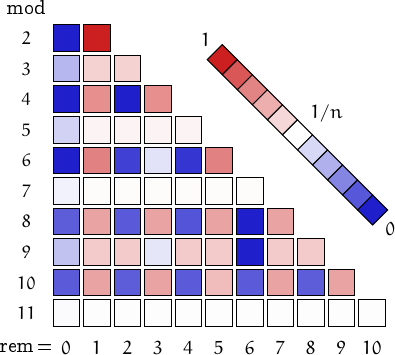The first 600 Duffinian numbers :
4, 8, 9, 16, 21, 25, 27, 32, 35, 36, 39, 49, 50, 55, 57, 63, 64, 65, 75, 77, 81, 85, 93, 98, 100, 111, 115, 119, 121, 125, 128, 129, 133, 143, 144, 155, 161, 169, 171, 175, 183, 185, 187, 189, 201, 203, 205, 209, 215, 217, 219, 221, 225, 235, 237, 242, 243, 245, 247, 253, 256, 259, 265, 275, 279, 289, 291, 299, 301, 305, 309, 319, 323, 324, 325, 327, 329, 333, 335, 338, 341, 343, 351, 355, 361, 363, 365, 371, 377, 381, 385, 387, 391, 392, 399, 400, 403, 407, 413, 415, 417, 425, 427, 437, 451, 453, 469, 471, 481, 484, 485, 489, 493, 497, 505, 511, 512, 513, 515, 517, 525, 527, 529, 533, 535, 539, 543, 549, 551, 553, 559, 565, 567, 575, 576, 578, 579, 583, 589, 595, 597, 603, 605, 611, 623, 625, 629, 633, 635, 649, 651, 655, 657, 667, 669, 671, 676, 685, 687, 689, 697, 707, 711, 713, 715, 721, 722, 723, 729, 731, 737, 741, 749, 755, 763, 767, 777, 779, 781, 784, 785, 791, 793, 799, 800, 803, 805, 813, 815, 817, 831, 833, 835, 837, 841, 845, 849, 851, 865, 867, 869, 871, 873, 875, 889, 893, 899, 900, 901, 903, 905, 913, 917, 921, 923, 925, 927, 935, 939, 943, 949, 955, 959, 961, 965, 968, 975, 979, 981, 985, 989, 993, 999, 1003, 1007, 1011, 1024, 1025, 1027, 1029, 1037, 1043, 1047, 1053, 1055, 1057, 1058, 1067, 1073, 1075, 1079, 1081, 1085, 1089, 1099, 1101, 1105, 1111, 1115, 1119, 1121, 1127, 1133, 1135, 1137, 1141, 1143, 1147, 1156, 1157, 1159, 1161, 1165, 1175, 1177, 1183, 1189, 1191, 1197, 1205, 1207, 1209, 1211, 1219, 1225, 1227, 1241, 1243, 1247, 1250, 1251, 1253, 1255, 1261, 1263, 1265, 1271, 1273, 1281, 1285, 1295, 1296, 1299, 1309, 1313, 1315, 1317, 1325, 1331, 1333, 1337, 1343, 1349, 1351, 1352, 1355, 1357, 1359, 1363, 1369, 1371, 1375, 1379, 1385, 1387, 1389, 1391, 1393, 1397, 1403, 1405, 1407, 1411, 1413, 1415, 1417, 1421, 1443, 1444, 1445, 1457, 1461, 1463, 1465, 1467, 1469, 1477, 1495, 1497, 1501, 1505, 1507, 1513, 1517, 1519, 1525, 1529, 1533, 1535, 1537, 1539, 1541, 1555, 1565, 1569, 1573, 1575, 1577, 1585, 1587, 1589, 1591, 1600, 1603, 1623, 1629, 1631, 1633, 1639, 1641, 1643, 1645, 1647, 1649, 1651, 1655, 1659, 1661, 1673, 1675, 1677, 1679, 1681, 1682, 1685, 1687, 1691, 1703, 1705, 1711, 1713, 1727, 1731, 1735, 1737, 1739, 1751, 1763, 1765, 1767, 1769, 1771, 1775, 1781, 1791, 1793, 1799, 1803, 1805, 1807, 1809, 1813, 1817, 1819, 1821, 1825, 1829, 1835, 1837, 1839, 1841, 1843, 1849, 1853, 1855, 1857, 1859, 1865, 1875, 1883, 1893, 1897, 1899, 1903, 1909, 1915, 1919, 1921, 1922, 1925, 1927, 1929, 1936, 1937, 1939, 1943, 1953, 1955, 1957, 1961, 1963, 1967, 1969, 1971, 1981, 1983, 1985, 1991, 2005, 2007, 2015, 2019, 2021, 2023, 2025, 2033, 2035, 2041, 2047, 2048, 2057, 2059, 2061, 2071, 2073, 2075, 2077, 2101, 2105, 2107, 2116, 2117, 2119, 2123, 2125, 2127, 2133, 2135, 2155, 2159, 2163, 2165, 2169, 2171, 2173, 2177, 2181, 2183, 2187, 2189, 2191, 2197, 2199, 2201, 2209, 2215, 2217, 2219, 2227, 2231, 2233, 2249, 2253, 2255, 2257, 2261, 2263, 2271, 2279, 2285, 2289, 2291, 2303, 2304, 2305, 2307, 2312, 2315, 2317, 2321, 2323, 2327, 2329, 2331, 2335, 2345, 2359, 2361, 2363, 2369, 2379, 2387, 2401, 2405, 2407, 2413, 2419, 2425, 2429, 2431, 2433, 2435, 2439, 2449, 2450, 2451, 2453, 2455, 2461, 2469, 2471, 2479, 2483, 2485, 2487, 2489, 2491, 2493, 2497, 2500, 2501, 2507, 2509, 2511, 2513, 2515, 2519, 2523, 2525, 2527, 2533, 2537, 2547, 2555, 2559, 2561, 2563, 2567, 2569, 2573.
Distribution of the remainders when the numbers in this family are divided by n=2, 3,..., 11. (I took into account 2543279 values, from 4 to 9999997).
| n\r | 0 | 1 | |||||||||
|---|---|---|---|---|---|---|---|---|---|---|---|
| 2 | 2450 | 2540829 | 2 | ||||||||
| 3 | 372851 | 1085074 | 1085354 | 3 | |||||||
| 4 | 1762 | 1270710 | 688 | 1270119 | 4 | ||||||
| 5 | 395961 | 536836 | 536756 | 536736 | 536990 | 5 | |||||
| 6 | 266 | 1084156 | 1266 | 372585 | 918 | 1084088 | 6 | ||||
| 7 | 340801 | 367634 | 367462 | 366632 | 367368 | 366615 | 366767 | 7 | |||
| 8 | 1199 | 635355 | 688 | 635065 | 563 | 635355 | 0 | 635054 | 8 | ||
| 9 | 124950 | 361693 | 361766 | 247901 | 361695 | 361809 | 0 | 361686 | 361779 | 9 | |
| 10 | 418 | 536362 | 545 | 536190 | 467 | 395543 | 474 | 536211 | 546 | 536523 | 10 |
| 11 | 226552 | 231785 | 231580 | 231610 | 231637 | 231834 | 231588 | 231649 | 231672 | 231693 | 231679 |
A pictorial representation of the table above

Imagine to divide the members of this family by a number n and compute the remainders. Should they be uniformly distributed, each remainder from 0 to n-1 would be obtained in about (1/n)-th of the cases. This outcome is represented by a white square. Reddish (resp. bluish) squares represent remainders which appear more (resp. less) frequently than 1/n.
e-mail: info -at- numbersaplenty.com • Privacy notice • engine limits